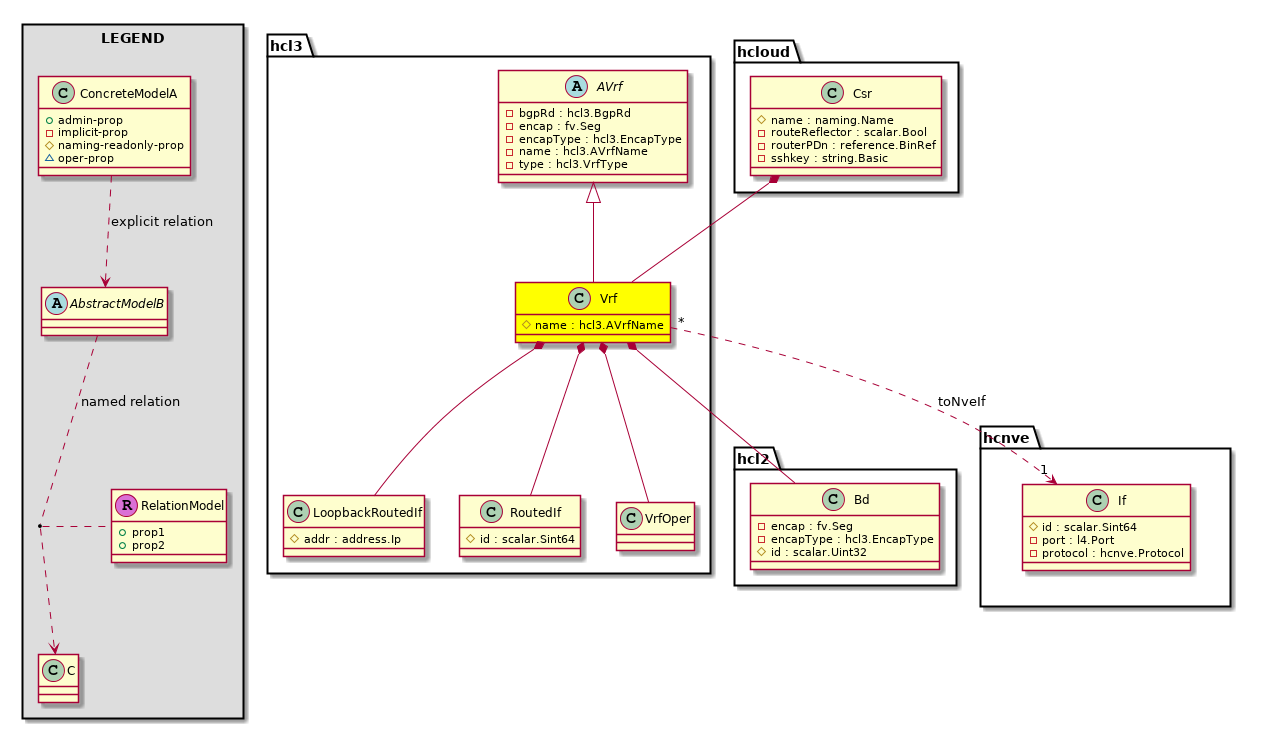| Properties Summary |
| Defined in: hcl3:AVrf |
hcl3:BgpRd
base:Uint8Array8
|
bgpRd (hcl3:AVrf:bgpRd)
The route-distinguisher for a VRF. The BGP is an L3 protocol used to learn routes, and the route-distinguisher helps the BGP learn routes in a specific VRF. The BGP can be run for multiple VRFs in a router, and because VRFs allow overlapping IP addresses between tenants, the BGP can get the same route (IP address) for two VRFs. The BGP uses the route distinguisher config to distinguish the routes received in the BGP packets from one VRF to another. Note that this is only applicable when multi-protocol BGP is enabled for a VRF.
|
fv:Seg
scalar:Uint32
|
encap (hcl3:AVrf:encap)
The port encapsulation.
|
hcl3:EncapType
scalar:Enum8
|
encapType (hcl3:AVrf:encapType)
NO COMMENTS
|
hcl3:VrfType
scalar:Enum8
|
type (hcl3:AVrf:type)
The specific type of the object or component.
|
| Defined in: mo:Resolvable |
mo:Owner
scalar:Enum8
|
lcOwn (mo:Resolvable:lcOwn)
A value that indicates how this object was created. For internal use only.
|
bgpRd
Type: hcl3:BgpRd
Primitive Type: base:Uint8Array8
Units: null
Encrypted: false
Access: implicit
Category: TopLevelRegular
Comments:
-
The route-distinguisher for a VRF. The BGP is an L3 protocol used to learn routes, and the route-distinguisher helps the BGP learn routes in a specific VRF. The BGP can be run for multiple VRFs in a router, and because VRFs allow overlapping IP addresses between tenants, the BGP can get the same route (IP address) for two VRFs. The BGP uses the route distinguisher config to distinguish the routes received in the BGP packets from one VRF to another. Note that this is only applicable when multi-protocol BGP is enabled for a VRF.
childAction
Type: mo:ModificationChildAction
Primitive Type: scalar:Bitmask32
Units: null
Encrypted: false
Access: implicit
Category: TopLevelChildAction
Comments:
-
Delete or ignore. For internal use only.
| |
| Constants |
| deleteAll |
16384u |
deleteAll |
NO COMMENTS
|
| ignore |
4096u |
ignore |
NO COMMENTS
|
| deleteNonPresent |
8192u |
deleteNonPresent |
NO COMMENTS
|
| DEFAULT |
0 |
--- |
This type is used to
|
|
dn
Type: reference:BinRef
Units: null
Encrypted: false
Access: implicit
Category: TopLevelDn
Comments:
-
A tag or metadata is a non-hierarchical keyword or term assigned to the fabric module.
encap
Type: fv:Seg
Primitive Type: scalar:Uint32
Units: null
Encrypted: false
Access: implicit
Category: TopLevelRegular
Comments:
-
The port encapsulation.
encapType
Type: hcl3:EncapType
Primitive Type: scalar:Enum8
Units: null
Encrypted: false
Access: implicit
Category: TopLevelRegular
Comments:
-
NO COMMENTS
| |
| Constants |
| unknown |
0 |
unknown |
Unknown
|
| vxlan |
1 |
ivxlan |
VXLAN tunnel
|
| vlan |
2 |
vxlan |
VLAN tunnel
|
| DEFAULT |
unknown(0) |
unknown |
Unknown
|
|
lcOwn
Type: mo:Owner
Primitive Type: scalar:Enum8
Units: null
Encrypted: false
Access: implicit
Category: TopLevelRegular
Comments:
-
A value that indicates how this object was created. For internal use only.
| |
| Constants |
| local |
0 |
Local |
NO COMMENTS
|
| policy |
1 |
Policy |
NO COMMENTS
|
| replica |
2 |
Replica |
NO COMMENTS
|
| resolveOnBehalf |
3 |
ResolvedOnBehalf |
NO COMMENTS
|
| implicit |
4 |
Implicit |
NO COMMENTS
|
| DEFAULT |
local(0) |
Local |
NO COMMENTS
|
|
modTs
Type: mo:TStamp
Primitive Type: scalar:Date
Units: null
Encrypted: false
Access: implicit
Category: TopLevelRegular
Comments:
-
The time when this object was last modified.
| |
| Constants |
| never |
0ull |
never |
NO COMMENTS
|
| DEFAULT |
never(0ull) |
never |
NO COMMENTS
|
|
name
Type: hcl3:AVrfName
Primitive Type: string:Basic
Overrides:hcl3:AVrf:name
Units: null
Encrypted: false
Naming Property -- [NAMING RULES]
Access: naming
Category: TopLevelRegular
Comments:
-
The name of the object.
rn
Type: reference:BinRN
Units: null
Encrypted: false
Access: implicit
Category: TopLevelRn
Comments:
-
Identifies an object from its siblings within the context of its parent object. The distinguished name contains a sequence of relative names.
status
Type: mo:ModificationStatus
Primitive Type: scalar:Bitmask32
Units: null
Encrypted: false
Access: implicit
Category: TopLevelStatus
Comments:
-
The upgrade status. This property is for internal use only.
| |
| Constants |
| created |
2u |
created |
In a setter method: specifies that an object should be created.
An error is returned if the object already exists.
In the return value of a setter method: indicates that an object has been created.
|
| modified |
4u |
modified |
In a setter method: specifies that an object should be modified
In the return value of a setter method: indicates that an object has been modified.
|
| deleted |
8u |
deleted |
In a setter method: specifies that an object should be deleted.
In the return value of a setter method: indicates that an object has been deleted.
|
| DEFAULT |
0 |
--- |
This type controls the life cycle of objects passed in the XML API.
When used in a setter method (such as configConfMo), the ModificationStatus
specifies whether an object should be created, modified, deleted or removed.
In the return value of a setter method, the ModificationStatus indicates the actual
operation that was performed. For example, the ModificationStatus is set to "created"
if the object was created. The ModificationStatus is not set if the object was neither
created, modified, deleted or removed.
When invoking a setter method, the ModificationStatus is optional:
If a setter method such as configConfMo is invoked and the ModificationStatus
is not set, the system automatically determines if the object should be created or modified.
|
|
type
Type: hcl3:VrfType
Primitive Type: scalar:Enum8
Units: null
Encrypted: false
Access: implicit
Category: TopLevelRegular
Comments:
-
The specific type of the object or component.
| |
| Constants |
| regular |
1 |
Regular VRF |
VRF Type is Regular
|
| shadow |
2 |
Shadow VRF |
VRF Type is Shadow
|
| DEFAULT |
regular(1) |
Regular VRF |
VRF Type is Regular
|
|

